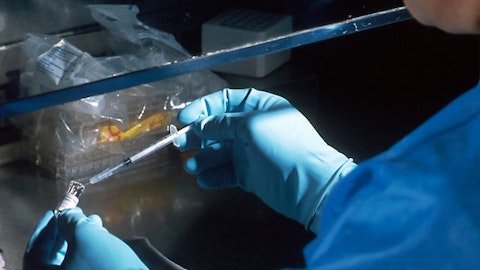And while we don’t have the data yet, we’ll have to run a study with one of those drugs to find out. We feel like, based on the literature, that there’s a potential to improve the tolerability of an incretin based therapy. So that brings us to kind of your second question, which is, you look at Amylin based therapies, GLP-1, GLP-2s. There are other things that are on the horizon, or maybe right here, right now, showing much better tolerability and so that’s top of mind for us when we think about selecting a partner and a program to bring onto the RaniPill. There’s tremendous interest in the obesity space to use the RaniPill by a number of potential partners. The thing for us is to find something that works today and will be competitive tomorrow when we’re in trials, and obviously when we get to commercial.
And then finally, I think maybe dovetails with what I just said, we are absolutely looking at the next generation. We’re going to take a portfolio approach to obesity. I don’t think there’s going to be one drug that can address the entire $100 billion category. And I think you’ll see over time, and all of you, as analysts will do this, you’ll start to bifurcate this into subcategories of patients; maybe with lower weight loss requirements, but maybe they have other adverse events.
Roux-en-Y: Maybe the production issues will be solved over the next four or five years, but I have a feeling that as much as we can produce as an industry of these obesity drugs, there’ll be patients who want to take them. So I think there’s a really good fit in this market for a RaniPill that can take an injectable dose and get injectable efficacy with dosing schedules, as I said, that you can’t do with a small molecule approach with an oral.
Julian Harrison: Very helpful, thank you.
Talat Imran: Yes, absolutely. Thank you for the questions.
Operator: And thank you. [Operator Instructions] And our next question comes from John Vandermosten from Zacks. Your line is now open.
John Vandermosten: All right, thank you and hello, Talat. Good afternoon. Starting out with a question on just assuming that Celltrion signs a deal with you and funds 111, how will your focus shift for the rest of your pipeline if that happens?
Talat Imran: It’s a good question. I mean, we’ve been talking about obesity assets, so it’s hard to describe something that we don’t have in the pipeline right now, but I think we are putting a lot of focus on making a selection there, and that would be a place to invest capital and then there’s RT-105. Humira remains a very popular drug amongst clinicians and patients and despite the biosimilars coming into the market, there’s just not a lot of differentiation there. So bringing a TNF-α oral in, perhaps a once a week pill is something that we’re thinking about in that space would be a really exciting product, I think.
John Vandermosten: Yes. As we think about RaniPill and kind of getting to later stages, manufacturing stages, I know you guys were working on some automated processes for manufacturing. How’s that coming along? And will you be using that for a clinical stage product?
Talat Imran: Yes, great question. We do need to automate, and we’ve made incredible strides over the last year. We have a fully dedicated in-house automation team that’s taking every step of the manufacturing process for the RaniPill and turning it into something that doesn’t require an operator that’s fully automated and then ultimately, we’ll string all of those pieces of equipment together to make a fully automated end-to-end line. As I said, we’ve made good progress. We’re shooting for a demonstration or pilot line that can deliver in the low thousands of pills per day and the goal is to have this ready for our Phase 3 studies. We don’t need it for the Phase 1s and Phase 2s. We have the capacity already to support those studies, but we would like to have that in place and then, of course, be able to work with a CMO partner that does mass scale production and scale that up so that we can make 50,000 or 100,000 pills per day per line, which is what we’ll need to do in order to commercialize any of these products.
John Vandermosten: Okay. And one more, if I may. I was doing some research on biosimilars, and was just looking at the rate of new biosimilars that are out there. I think there were about nine approved in the last 12 months. What do you think about the environment for more biosimilars to come? It started off pretty slowly about a decade ago, especially in the U.S. What are your thoughts about this and kind of the maybe legislative environment for accelerated growth of biosimilars?
Talat Imran: Right. I think that there are a couple points here. The first is that everyone from Congress to patients, clinicians, payers, should want biosimilars, because exclusivity from patents is good, because it allows for innovation, but you don’t want to keep prices for an old drug high artificially forever. So we need biosimilars, but we also need to, I think, as not just our industry, but the healthcare industry writ large, needs to look at rebates, how things are paid for. And I think the Amgen example of the two prices they gave for their Humira biosimilar and which one had uptake, says a lot about how the PBM and payer market works or doesn’t work if I can say that. I think that there’s going to be more biosimilars coming in, but the only thing they can compete on is price.

